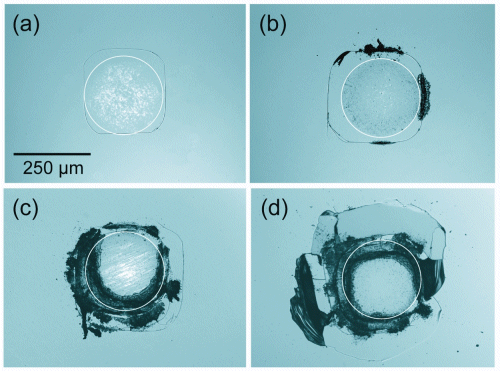Researchers claim stressed-induced cracks are formed at the microscopic scale of silicon-based MEMS devices
Researchers at the National Institute of Standards and Technology (NIST) have developed a mechanical stress process that causes cracks in bulk silicon crystals. Until now it was believed that silicon was immune to breakdowns of this kind. The results showed that this would mostly affect the design of silicon-based MEMS devices that have been proposed for a wide range of uses.

Optical micrographs of contact damage in silicon from cyclic stress show progressive damage after (a) 1,000 cycles, (b) 5,000 cycles, (c) 20,000 cycles, and (d) 85,000 cycles.
From conventional tests, silicon was shown to be immune to fatigue caused by cyclic stress due to the nature of its crystal structure and chemical bonds. However, recent study into silicon MEMS devices showed that these microscopic systems that integrate tiny gears, vibrating reeds, and other mechanical features can develop stress-induced cracks, which cause failure.
There are two possible reasons that cracks occur at the microscopic scale: one is that the effect is purely mechanical, due to friction, and the other is that the cracks are essentially caused by corrosion (a chemical effect). Since the phenomenon has only been noticed at submicrometer scales, the team was unable to confirm which theory is valid.
The testing was done by pressing the top of the crystals with tiny tungsten-carbide spheres about 3 mm in diameter at pressures below the silicon’s breaking point. Pressing down hard on the crystal for days at a time caused no detectable cracks (a debate against the corrosion theory). However by using half the pressure and cycling the test hundreds of thousands of times revealed a gradually increasing pattern of surface damage at the indentation site (a clear indication of mechanical failure). The researchers concluded that the critical element in their experiments is the addition of shear stress (causing the crystal planes to slide against each other), a component nonexistent in traditional strength tests, but not uncommon in real applications.
These experiments showed fatigue effects in silicon at the comparatively large scale of hundreds of micrometers. The next step for the researchers would be to determine if the same mechanisms operate at the submicrometer level. For more information, call Michael Baum at 301-975-2763 or e-mail
.
Christina Nickolas
Advertisement
Learn more about National Institute of Standards and Technology





